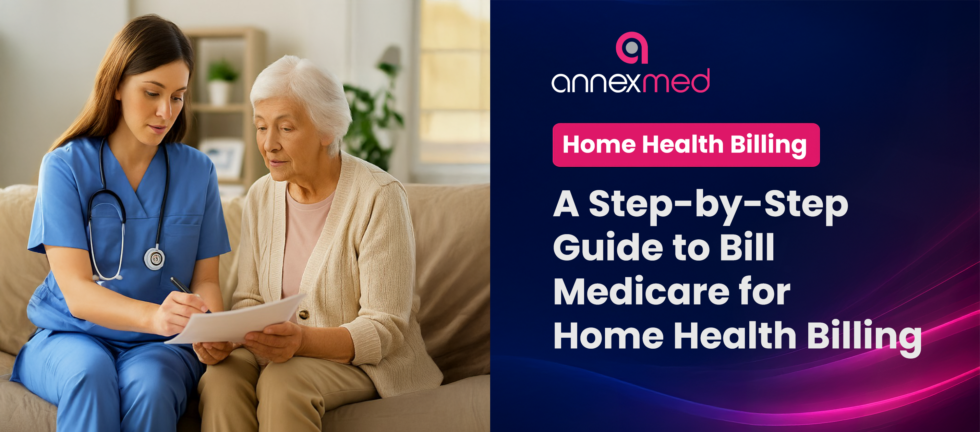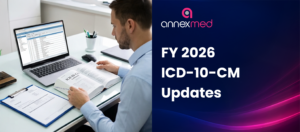If you’ve worked in home health billing long enough, you know one thing, Medicare never sits still.
Each year brings new rules, rate recalibrations, and compliance details that directly affect how agencies get paid. And 2026 is no different.
Between a proposed 6.4% payment cut, PDGM recalibration, and some quality reporting and value-based changes, billing teams will need to stay more organized than ever to keep claims moving cleanly through the system.
This guide breaks down what’s changing in 2026 Medicare home health billing, how the Notice of Admission (NOA) fits in, and what the PDGM adjustments really mean in day-to-day operations.
Table of contents
- 1. Understanding the 2026 Home Health Payment Outlook
- 2. PDGM Recalibration: What Billers Should Watch
- 3. Temporary 5% Recoupment Adjustment
- 4. NOA Requirements: No Changes, Still Strict
- 5. Face-to-Face (F2F) Flexibility
- 6. Quality Reporting (HH QRP) and Value-Based Updates
- 7. Provider Enrollment & Compliance Reinforcement
- 8. DME Coordination: Stricter Oversight Ahead
- Preparing for 2026: A Billers Checklist
1. Understanding the 2026 Home Health Payment Outlook
According to the CY 2026 Home Health Proposed Rule, CMS expects a net 6.4% reduction in total Medicare payments compared to 2025.
Here’s what’s driving that:
- +2.4% market basket update (standard inflationary adjustment)
- -4.059% permanent behavioral adjustment
- -5.0% temporary adjustment to start recouping PDGM overpayments from 2020–2024
- Minor adjustments from outlier recalibration
The result? Many agencies will need to tighten cash flow and track LUPAs and visit utilization more closely, since the average payment per 30-day period will drop once these changes go live.
2. PDGM Recalibration: What Billers Should Watch
PDGM continues to evolve, and for 2026 CMS plans to recalibrate nearly every part of the model:
- Case-mix weights for all 432 payment groups
- Functional impairment scoring (based on OASIS data)
- Comorbidity subgroup definitions
- LUPA thresholds across the board
This means two agencies providing the same care in 2025 and 2026 might see different reimbursement amounts for the same clinical grouping.
For example:
- A wound care episode with multiple comorbidities might gain slightly under the new weights.
- A stable MMTA (Medication Management, Teaching, and Assessment) case could lose a few percentage points in payment.
What this really means for billing teams: double-check OASIS documentation and make sure diagnosis sequencing aligns with PDGM logic. Even small coding differences can shift the HIPPS code and reduce payment.
Strengthen PDGM accuracy with AnnexMed’s Revenue Cycle Management.
3. Temporary 5% Recoupment Adjustment
CMS has proposed a one-year temporary 5% reduction in 2026 to start recovering overpayments made during early PDGM implementation years (2020–2024).
This adjustment is in addition to the ongoing -4.059% permanent behavioral adjustment.
In practice, that means:
- Every 30-day payment will be a little leaner.
- Agencies should expect at least one quarter of cash flow compression.
- Recoupment will likely continue into future years if CMS determines additional overpayment recovery is needed.
Now’s the time to review visit utilization, validate your documentation, and reduce avoidable LUPAs, since PDGM relies heavily on functional and clinical coding accuracy.
4. NOA Requirements: No Changes, Still Strict
If there’s one rule that hasn’t changed, it’s the Notice of Admission (NOA).
Even in 2026, agencies must submit the NOA within five calendar days from the start of care. Each day late cuts into reimbursement for that period.
Example:
Start of care = March 3
NOA due = March 8
Filed on March 10 = payment reduced by 2 days
Common issues that still cause NOA delays:
- Missing face-to-face encounter documentation
- Mismatched admission date
- Patient not yet linked to a valid Plan of Care in the system
CMS hasn’t proposed any timeline or policy changes for NOA in 2026, so your existing workflows still apply, but timeliness matters more than ever.
Prevent NOA-related write-offs with AnnexMed’s Denial Management Services.
5. Face-to-Face (F2F) Flexibility
There’s one piece of good news, CMS plans to expand who can perform the face-to-face encounter. Starting in 2026, physicians, NPs, PAs, and clinical nurse specialists can all complete the F2F visit, even if they aren’t the same provider who certifies the Plan of Care.
This is designed to reduce eligibility denials caused by missing or mismatched F2F documentation.
6. Quality Reporting (HH QRP) and Value-Based Updates
CMS is also updating quality reporting and value-based purchasing requirements for 2026.
Home Health Quality Reporting Program (HH QRP):
- Removing outdated COVID-19 vaccine and utility-related assessment items
- Shortening the data submission window (from 4.5 months to 45 days)
- Exploring the use of digital quality measures (dQM)
Value-Based Purchasing (HHVBP):
- Dropping three HHCAHPS satisfaction measures
- Adding four functional and claims-based measures (e.g., Medicare Spending per Beneficiary)
- Reweighting the measure categories to prioritize outcomes over surveys
Bottom line: Agencies that document strong functional improvement (ADLs, mobility, wound
7. Provider Enrollment & Compliance Reinforcement
CMS continues tightening program integrity across home health. The 2026 proposal includes:
- More grounds for retroactive revocation or deactivation of billing privileges
- Enhanced ownership disclosure requirements
- Cross-checks for providers with high denial or revocation rates
Agencies should proactively audit PECOS data and confirm that their billing numbers, ownership records, and affiliations are up to date
8. DME Coordination: Stricter Oversight Ahead
While DME billing runs separately from home health claims, the two often overlap operationally. In 2026, CMS plans to:
- Require annual reaccreditation for DME suppliers (currently every three years)
- Implement stricter AO (Accreditation Organization) monitoring
- Offer prior authorization exemptions to suppliers with ≥90% approval rates
That means agencies should refer patients to high-compliance DME suppliers, since claim denials and delays can now directly affect patient satisfaction and continuity of care.
Preparing for 2026: A Billers Checklist
Here’s what every home health billing team should do before January 2026:
- Model your revenue impact. Build a rate forecast factoring in a -6.4% overall adjustment.
- Refresh PDGM knowledge. Review functional scoring and comorbidity logic before recalibration goes live.
- Tighten NOA workflows. Late NOAs remain the most preventable cause of payment loss.
- Shorten your reporting cycle. Prepare for a possible 45-day QRP submission window.
- Audit compliance. Keep F2F, OASIS, and provider enrollment records audit-ready.
Home health billing in 2026 will require more precision and better planning than ever before. With reimbursement cuts, recalibration, and tighter compliance controls, success will depend on how well agencies align documentation, coding, and billing with CMS’s expectations.
Simplify Home Health Billing
AnnexMed helps home health agencies stay compliant with evolving Medicare rules. From PDGM coding and NOA tracking to documentation audits and denial prevention, our team ensures your billing process is accurate, timely, and stress-free.




























